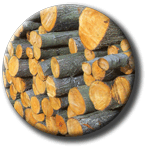Felling Licences
E
 veryone
needs permission from the Forestry Authority (a part of the Forestry
Commission) to fell growing trees, unless the operation is exempt. Before
you get too excited about this, the exemptions cover quite a lot. In fact, the
effect of the legislation is to ensure that a licence is needed for most large-scale,
commercial forestry, but almost everything else is exempt in most cases (see
below). The Forestry Authority normally imposes certain conditions on a
licence, and the most significant of these is the restocking condition. This
has the effect of ensuring that the area felled is replanted appropriately in
due course. Grants are also available to help with this. Occasionally this condition
is waived, but this is quite unusual. This means that if a landowner takes it
into his head to fell a woodland and plough it up for arable crops, the Forestry
Authority can prosecute and insist on restocking.
veryone
needs permission from the Forestry Authority (a part of the Forestry
Commission) to fell growing trees, unless the operation is exempt. Before
you get too excited about this, the exemptions cover quite a lot. In fact, the
effect of the legislation is to ensure that a licence is needed for most large-scale,
commercial forestry, but almost everything else is exempt in most cases (see
below). The Forestry Authority normally imposes certain conditions on a
licence, and the most significant of these is the restocking condition. This
has the effect of ensuring that the area felled is replanted appropriately in
due course. Grants are also available to help with this. Occasionally this condition
is waived, but this is quite unusual. This means that if a landowner takes it
into his head to fell a woodland and plough it up for arable crops, the Forestry
Authority can prosecute and insist on restocking.
There is a public register of applications for felling licences.
All applications have to rest there for 4 weeks and any person or body can comment
on them. In practice, comments are quite rare as few people bother to check
the list. You can see all the applications for felling licences in your area
on the internet. You can even get it emailed to you if you so choose. This very
useful facility can be found at the Forestry Commission's Public
Register website. Have a look now and see who is going to be felling what!
In any calendar quarter a landowner is allowed to fell up
to 5 cubic metres of timber on their property without a licence, so long as no
more than 2 cubic metres are sold. This is quite a lot of wood and is certainly
well in excess of anything likely to be needed on any domestic property, for example.
Beyond this, these are the main exemptions:
1. Lopping and topping, including most tree surgery, pruning
and pollarding.
2. Felling included in an approved plan under a Forestry Commission grant
scheme (e.g. Woodland Grant Scheme)
3. Felling fruit trees, or trees growing in a garden, orchard, churchyard
or other designated public open space.
4. Felling trees which, when measured at a height of 1.3m from the ground:-
1. have a diameter of 8cm or less; or
2. if thinnings (trees removed from amongst other trees to allow their growth)
have a diameter of 10cm or less; or
3. if coppice or underwood (trees as a part of a layer below the main forest
canopy) have a diameter of 15cm or less.
5. Felling trees immediately required to implement a planning permission.
6. Felling trees for work carried out by some service providers (e.g. electricity,
water) and which is essential to carry out those services.
7. Felling necessary to prevent the spread of a disease and done in accordance
with a notice served by the Forestry Authority.
8. Felling in compliance with an Act of Parliament.
Information on this page is derived from the free Forestry
Authority leaflet "Tree felling: getting permission" (July 1997)

 veryone
needs permission from the Forestry Authority (a part of the
veryone
needs permission from the Forestry Authority (a part of the